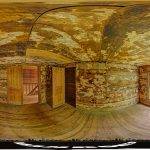Discovering the Forgotten: The Story of the Space Shuttle External Tank in Green Cove Springs, Florida
Explore the captivating presence of the Space Shuttle External Tank, strategically positioned alongside a road in Green Cove Springs, Florida. This unique attraction is a must-visit for urban explorers and space enthusiasts alike, offering a comprehensive 360-degree panoramic experience. Surrounding the monumental orange tank, there are 10 meticulously captured panoramic images, each offering a unique perspective on this iconic piece of space history. Included among these are 5 aerial views that elevate your viewing experience, allowing you to appreciate the sheer scale and striking color of the tank against the Florida landscape. This visual journey not only adds an educational twist to your exploration but also provides an immersive way to appreciate the complexities of space travel technology.
Click here to view it in fullscreen.
In the quaint, almost forgotten docks of Green Cove Springs, an unusual artifact stands quietly, drawing the eyes and stirring the curiosity of those who pass by. It is not a relic from a maritime voyage, nor is it a forgotten piece of industrial machinery. It is, surprisingly, a full-scale model of a Space Shuttle external fuel tank, one of the massive orange cylinders that once propelled human ingenuity into the cosmos. This artifact, while silent and stationary, carries a rich tapestry of stories spanning decades, a testament to the daring dreams of space exploration.
The Historical Significance of the Space Shuttle External Tank
The external fuel tank in question is no ordinary museum piece. It is the third and final test tank developed for the iconic Space Shuttle Program, a cornerstone of NASA’s efforts to explore space. Between 1977 and 1980, this tank was subjected to intense structural and stress testing at NASA’s Marshall Space Flight Center in Huntsville, Alabama. These tests were critical, ensuring that the tanks used in missions were capable of withstanding the extreme conditions of space travel, thereby safeguarding the lives of astronauts and the integrity of the spacecraft.
A Journey Across Time and Space
After its rigorous testing phase, this behemoth of space history embarked on a journey across various NASA sites. It was first displayed at NASA’s Stennis Space Center in Mississippi, and later, in 1997, moved to Kennedy Space Center in Florida. Here, it stood as a tangible link to the stars, an educational tool that allowed visitors to grasp the scale and complexity of the machinery that carried humans beyond our earthly confines.
Following the closure of the Space Shuttle Program in 2011, with the final flight of the Space Shuttle Atlantis, NASA began to disperse its remaining space artifacts. This external tank was included in these items and soon found itself at the heart of an auction. The logistical nightmares of transporting such a colossal artifact led the initial auction winner from California to withdraw their bid, paving the way for the Wings of Dreams Aviation Museum in Keystone Heights, Florida, to acquire it.
The Logistical Odyssey
Transporting the external tank was a monumental task. It involved a 200-foot barge, two tugboats, and multiple cranes to maneuver the tank from Kennedy Space Center to its temporary docking spot at Green Cove Springs. The plan was simple in conception but complex in execution: the tank would only stay temporarily before being moved to its final destination at the museum.
However, reality soon interjected with logistical challenges that transformed this “temporary” stay into a more permanent arrangement. The path to Keystone Heights was littered with obstacles such as low-hanging electrical and telephone wires and inadequate road conditions. Bob Oehl, the executive director of the museum, highlighted the daunting tasks that lay ahead: closing two state highways and temporarily removing numerous power lines would be necessary to proceed.
A Symbol of Human Ingenuity
Today, the tank remains at the Port of Green Cove Springs, a poignant symbol of human curiosity and technological ambition. Its presence here serves not only as a reminder of the complexities involved in space travel but also as a celebration of the triumphs. It stands as a testament to the Space Shuttle Program and to the dedication of the countless individuals involved in its successes.
The Enduring Fascination with Space
This external fuel tank, once an integral component in testing the boundaries of space exploration, has now become a cherished historical exhibit. It underscores the ongoing human fascination with space and reflects the stories of those who have dared to explore beyond the familiar. It invites passersby and enthusiasts to ponder the vastness of our achievements in space and to draw inspiration from the engineering marvels that have made such ventures possible.
In conclusion, while the external tank of the Space Shuttle might have been retired from active duty, its journey from a critical test element to a historical exhibit captures the enduring spirit of exploration. It remains, in Green Cove Springs, a beacon for those who are fascinated by history and the mysteries of the universe, continuing to inspire awe and curiosity in all who come to see it.
If you liked this blog post, you might like these other aerospace related post, the abandoned Launch Complex 34, the Operations Control Building or the Launch Complex 14 all at the Cape Canaveral Space Force Station in Florida.

A 360-degree panoramic image showing the Space Shuttle External Tank in Green Cove Springs, Florida. Image by: Abandonedin360 Team
Do you have 360-degree panoramic images captured in an abandoned location? Send your images to Abandonedin360@gmail.com. If you choose to go out and do some urban exploring in your town, here are some safety tips before you head out on your Urbex adventure.
Unlock the secrets of exploration by diving into precise GPS data available exclusively for an array of hidden gems and hundreds of other captivating sites, all within our members’ section. By investing in a Gold Membership, you’re not just gaining access; you’re securing a key to a vast, global archive of abandoned, untouched, and mysterious locations waiting to be discovered. Embark on your adventure with confidence, knowing every corner of the world can be within your reach. Don’t just observe—explore, discover, and claim the extraordinary journey that lies ahead with our treasure trove of world secrets. Subscribe now and transform the way you see the world!
Equipment used to capture the 360-degree panoramic images:
- Canon DSLR camera
- Canon 8-15mm fisheye
- Manfrotto tripod
- Custom rotating tripod head
- DJI Mavic 3 Classic
If you want to start shooting 360-degree panoramic images, you might want to look onto one-click 360-degree action cameras.
Click on a state below and explore the top abandoned places for urban exploring in that state.






